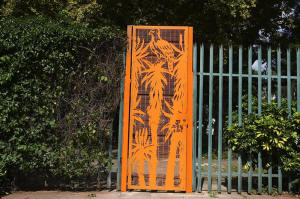A South African artist hopes vibrant sculptures make parks more
welcoming in a city known for danger
[March 10, 2025]
By MICHELLE GUMEDE
JOHANNESBURG (AP) — James Delaney wants his public art in South Africa's
biggest city to be more than a magnet for selfies and a delight for
children. He's determined to have the vibrant metal sculptures change
the mood of its gritty and sometimes dangerous neighborhoods.
Over the past decade, Delaney has designed more than 100 sculptures for
The Wilds Park in Johannesburg. A striking red steel kudu antelope
stands near a hill’s summit. A curious assembly of stencil owls peer
down from jacaranda trees. A life-size pink giraffe installation
dominates a grassy clearing.
“Artworks can bring a sense of life to public spaces,” said Delaney, a
53-year-old sculptor and painter who has exhibited his work in London,
Paris and New York.
“And public spaces need lots of people to be functional and to be safe.”
Authorities in Johannesburg have encouraged public art to improve safety
and environmental conditions in the city of some 6 million people whose
downtown has a reputation for crime and degradation. Johannesburg is
considered one of the world's most dangerous cities, based on crime
data.

Much of Johannesburg's street art and public works reflect South
Africa's former life under the white minority rule of apartheid and the
efforts at reconciliation after that divisive system ended.
Delaney's work strives to do something simpler for residents in a city
where dirty, uninviting sidewalks and safety concerns make it rare for
the average person to take a stroll.
“One can create a public space which is grass and trees and it’s OK and
nice. But one has to do more than that to really attract people and to
capture their imagination," Delaney said.
The Wilds is in the midst of Johannesburg's contrasts.
One side of the park is bordered by the tree-lined Killarney suburb and
affluent Houghton, home to Nelson Mandela during the final years of his
presidency as the country's first Black leader. The other side borders a
transition into the bustling, sometimes broken-down areas of Berea and
Yeoville.
Lydia Ndhlovu, a 38-year-old mother, watched her children play on the
jungle gym, a break from their apartment with no yard.
“I don’t feel safe being alone here with them, but I like seeing the
elderly people enjoying the park from my window, because then I know we
can be free and also come,” she said.
[to top of second column]
|

The newly installed gate by a sculptor and painter James Delaney, at
the Killarney Park in Johannesburg, South Africa, Tuesday Feb. 18,
2025. (AP Photo/Alfonso Nqunjana)

Some residents say Johannesburg's reputation for crime is unfair.
“Quite often the narrative in the city of Johannesburg is all parks are
unsafe,” said Jenny Moodley, a spokeswoman for Johannesburg City Parks,
which maintains 22 nature reserves, 15 bird sanctuaries and more than
2,000 public parks.
“Many of these open spaces are safe, little children play unsupervised,
and we know elements such as art reinforce that this is a vibrant space
to play, to come together with your families and friends and to also
express yourself,” Moodley said.
Delaney first encountered The Wilds as an overgrown, deserted park while
walking his puppy Pablo — named after Picasso — in 2014. Since then, he
has repaired and painted benches, pruned plants and attracted volunteers
and donors to help turn it into a buzzing meeting point.
The special ingredient might be the sculptures that now draw moms with
babies, yoga enthusiasts and schoolchildren from nearby apartment
blocks.
Delaney last week unveiled a second urban park regeneration in
Killarney, where a 3-meter-high (9.8-foot) bright orange gate features a
sculpture of a raptor perched on a native aloe plant, encouraging
passers-by to enter and explore.
Anna Starcke, an 88-year-old former political analyst and journalist, is
one of Killarney's oldest residents, though her pink lipstick and green
sunglasses strike a more contemporary tone. To her, the art in the parks
speaks of inclusion. One of the delights of her day is chatting with
other visitors.
“It’s very important that people get the feeling that it’s theirs
because that is the big thing, that Black people (during apartheid)
never felt it’s theirs,” she said. “If we can get a majority of people
to care about their parks, art in their parks, and being together in
their parks, sitting on the same bench, then we have won."
All contents © copyright 2025 Associated Press. All rights reserved
 |